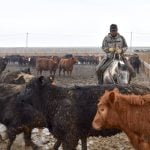A number of years ago Alberta producer Gerald Oloske injured his hand during harvest while working on a combine. It was in that moment of crisis that he realized his equipment didn’t have first aid kits. While he was feeling shock coming on, he resolved to create kits for all his equipment. Over the years he has refined the kits to suit each farm task.
Oloske’s rule of thumb is to have a kit in every piece of equipment that you get into and to ensure you have enough supplies in each kit to treat your crew. He strives to have a nine to 10 person kit in each piece of equipment. He’s also taken time to print up stickers that show the equipment has a first aid kit inside.
Read Also

The issue with scar tissue
Without a healthy amount of movement, friction and influence during the healing process, scar tissue may later disrupt how the body moves around it, so maintenance is needed as soon as an incision or wound heals over, Kathlyn Hossack writes.
“If you hurt something, like cutting your finger, and there isn’t anything clean in the cab for a bandage, just oily or dirty rags, you leave yourself open for an infection.” Oloske says.
With the amount of chemicals, lubricants, dirt and debris you find working on a farm of any type, proper treatment of a wound right after the injury happens is very important. A proper and accessible first aid kit is the best thing to have.
Oloske usually uses pre-made first aid kits from industrial safety companies and then adds his own farm specific touches. Things like an eyewash bottle for the sprayer; welding gloves for combines. Each kit should also have a first aid tip card.
Many field operations are done alone, so having a contact card in the kits is important. Oloske keeps more than the number for 911 on the contact cards in his kits — he includes the local dealership main and after hours numbers, any neighbours who could come and help, the local fire/ambulance hall number and family member numbers.
It is very important to know what items are in your first aid kit and how to use them. Restocking and assessing your kits on a regular basis ensures they have what you might need for the jobs you’re doing. Keep an inventory card in your kit, and put your kits inside a large zipper bag to keep them clean.
By putting the stickers on the windows you let everyone know there is a kit inside the cab if one is needed.
First aid training has become more accessible. At least one person on a crew should have first aid and CPR training.
Producers can, of course, build their own kits. Keep in mind that although a first aid kit may seem expensive, if you have to put it together piece by piece you may not see a big cost savings.
The importance of having kits in all your equipment is huge. It means you or your workers will have access to items that can help them if they are injured.
If you would like information on Oloske’s kids, call Gerald at 780-920-4868.














